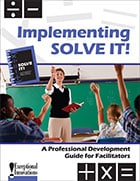
Solve It! is a structured approach that incorporates effective instructional strategies for teaching math word problems.
Solve It! is a structured approach that incorporates effective instructional strategies for teaching math word problems, including the following top 10:
- Cueing/Prompting
- Generalization
- Immediate and Corrective Feedback
- Modeling
- Verbal Rehearsal
- Maintenance
- Overlearning
- Positive Feedback
- Mastery Learning
- Mnemonics
Following is a quick reference guide for strategies 1–5 of the Solve It! top 10 strategies. Each features a definition and a vignette showing how the strategy is used when teaching the Solve It! approach to solving math word problems. (Click here to read more about strategies 6–10.)
1. Cueing/Prompting Strategy
Definition: Use verbal, written, or visual reminders that guide or give direction to students to respond correctly. For example, Ms. Williams provides appropriate cues and prompts during acquisition and application of new skills and strategies. She provides cues and prompts as students are just learning the Solve It! approach. Later, students will use their Solve It! Student Cue Cards and Master Class Charts to guide them as they practice math problems.
Vignette: Ms. Williams displays the Solve It! Master Class Charts in the classroom. After introducing the cognitive approach (Lesson 1), Ms. Williams proceeds to provide group practice in verbally rehearsing the approach. Using a pointer, Ms. Williams points to “Read” and verbally and visually cues the students to read “for understanding” by saying and pointing to each word “for understanding.” She then points to SAY and cues students in the same way to “Read the problem. If I don’t understand, read it again.” She proceeds in the same manner for the remainder of the steps. When students understand the process, she fades the verbal cues and uses the pointer (the visual cue) to elicit students’ responses. During all verbal rehearsal practice sessions, Ms. Williams alternates between using the technique with individual students and groups. Students can then become the prompter for the class to reinforce learning. At the end of the lesson, Ms. Williams distributes the Solve it! Student Cue Cards. She invites students to use them as they memorize the Solve it! steps.
2. Generalization Strategy
Definition: Transfer what is learned to a new task, setting, or situation. For example, a student uses the Solve It! approach successfully in the learning disabilities resource room and then uses the approach to solve problems successfully in the general education math classroom. Note: Students may need to be cued to use Solve It! in new settings, with different types of problems, and in different situations such as figuring how much money they will make per week in their afterschool job.
Vignette: After students learn the Solve It! approach, Ms. Williams presents a practical problem to the students to help them generalize the Solve It! steps to real life problems.
Ms. Williams says, “Who gets an allowance?” Students raise their hands. Then she says, “Write down how much money you get and how often you get it.” Ms. Williams spot checks students and asks, “Who gets paid for working after school, for example, babysitting or mowing lawns?” Students raise their hands and Ms. Williams says, “Write down how much you make and how often you make it.” Again, she spot checks students. Ms. Williams asks, “Who does not get an allowance or get paid for working?”
Ms. Williams then pairs students who do not do either with a student who does, and says, “Now, think about something you want to buy and estimate its cost. Write down the cost. Now calculate how long it will take you to save the money needed to buy what you want to buy. If you have a partner, work as a team.” Ms. Williams assists students as needed. When students finish, they present their calculations to the class.
3. Immediate and Corrective Feedback Strategy
Definition: Locate and correct students’ errors and then explain the errors and how they can be corrected.
Vignette: Ms. Williams reviews Jorge’s responses to the problems on the Mathematical Problem Solving Assessment—Short Form. She reviews his answer to the second problem:
Four friends have decided they want to go to the movies on Saturday.
Tickets are $2.75 each for students.
Altogether they have $8.40. How much more money do they need?
It was clear that Jorge understood how to do the problem because he first multiplied 2.75 by 4 and then subtracted 8.40 from that number (11). However, his answer to the question was incorrect. Ms. Williams provided the following corrective feedback:
Ms. Williams says, “Jorge, I see from your work that you understood how to do the problem, but your answer is wrong for a very simple reason. Can you find the mistake?”
Jorge checks his computation and finds his subtraction error. Ms. Williams says, “That’s right. You made a subtraction error because you did not regroup correctly. What is the correct answer?”
Jorge responds with $2.60 and Ms. Williams says, “That’s correct. In the future how could you avoid making that error?”
Jorge responds that he would check his work, and Ms. Williams says, “Yes, that’s right. We can check our computation by using the reverse operation. For this subtraction problem, I would add.” She demonstrates how to add 2.60 and 8.40: 0+0=0; 6+4=10 and carry the 1; 1+2=3+8=11. Ms. Williams says, “You would have discovered your mistake by checking. So, checking is something you need to do when solving math problems.”
4. Modeling Strategy
Definition: Watch and listen as others perform a task correctly. For example, in Solve It!, the teacher models how successful problem solvers think and behave as they solve math problems. Students then model the approach.
Vignette: Ms. Williams models how to think and behave as she solves the first two cognitive processes in the Solve It! approach.
Ms. Williams says, “Hear me say everything I am thinking and doing as I solve this problem.”
A data entry clerk earns $8.00 per hour plus $0.50 for each full page of data entered into the computer.
How much money, in dollars, will the clerk earn after working 30 hours and entering 140 full pages of data?
SAY: Read the problem for understanding. Okay, I will do that. (Ms. Williams reads the problem.) If I don’t understand it, I will read it again. Hmm, I think I need to read it again. (She reads the problem again.)
ASK: Are there any words or terms I don’t understand? Let me look again. The only word I am not sure about is “per.” $8 per hour. Oh, I get it. That means $8.00 for each hour. So, “per” means “each.” Have I read and understood the problem? I think so.
CHECK: Check for understanding as I solve the problem. Okay, I will make sure I understand what I am doing as I go.
SAY: Next, I am going to paraphrase by putting the problem into my own words. Okay. This guy is paid $8.00 per hour for his work. He works 30 hours. Also, he is paid $.50 for each page. He finishes 140 pages. How much did he make? Now underline the important information. I am going to underline $8.00 per hour plus $0.50 for each full page, how much money (in dollars), 30 hours, and 140 full pages.
ASK: Have I underlined the important information? Yes, I have. What is the question? The question is “how much, in dollars, did the clerk earn?” What am I looking for? I am looking for the total amount of money he made for working 30 hours and finishing 140 pages.
CHECK: Check that the information goes with the question. I have the number of hours he worked, the amount he made each hour, the number of pages he finished, and the amount he made for each page. I need to find the total amount he made. I have the information I need.
5. Verbal Rehearsal Strategy
Definition: Verbalize aloud the components of a task or strategy until the components are committed to memory. For example, in Solve It!, students are required to memorize the cognitive approach to 100 percent mastery. When they start applying Solve It! to math word problems, they are required to think aloud as they use the cognitive approach for solving problems until they use it with facility.
Vignette: Ms. Williams is checking mastery of students’ memorization of the Solve It! approach in Lesson 2. She has the list of students on a chart posted on the chalkboard along with boxes for three days.
Ms. Williams says, “Everyone will reach 100 percent mastery of the Solve It! approach, the RPV-HECC approach, in three days. You practiced the approach that you learned yesterday for homework. If you make a mistake, I will help you.” Ms. Williams gives everyone an opportunity to recite the approach and provide cues when students make mistakes. She gives each student a gold star on the chart when he or she recites it to 100 percent mastery. In his way, students hear the Solve It! steps repeatedly. All students will reach criterion.
Read about strategies 6–10 here.
Learn More
 Implementing Solve It! A Professional Development Guide for Facilitators contains numerous activities and tools for understanding Solve It!. While teachers can learn the Solve It! approach from the manual, learning is often enhanced by studying the Solve It! components in more depth.
Implementing Solve It! A Professional Development Guide for Facilitators contains numerous activities and tools for understanding Solve It!. While teachers can learn the Solve It! approach from the manual, learning is often enhanced by studying the Solve It! components in more depth.
The facilitator’s guide provides a variety of professional development activities that can be used in workshops, by teachers working alone or in teams, in coaching sessions, and so on. The activities correspond with the elements of the Solve It! approach and are organized as chapters in the guide that include:
- Understanding the Solve It! Approach. This chapter provides suggestions for introducing Solve It!.
- Becoming Skilled in the Solve It! Process. This chapter provides suggestions for understanding and developing the cognitive strategy instruction that forms the basis for the Solve It! approach.
- Becoming Skilled in the Solve It! Instructional Components. This chapter provides suggestions for developing key instructional strategies that are used when presenting Solve It! to students.
- Learning How to Use the Solve It! Assessments. This chapter provides suggestions for administering, interpreting, and using the Solve It! assessments.
- Putting It All Together—Implementing Solve It!. This chapter provides suggestions for organizing Solve It!. Attention is given to supporting implementation.
For more information, see https://www.exinn.net/solve-it/implementing-solve-it-2/.
